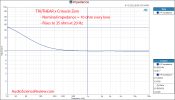You're making the mistake of seeing the fundamental frequency as the entirety of a note. If that were the case it would make very low notes, that indeed are popular in modern music, inaccessible to the majority of the public. Also a Theremin and a Piano would sound the same. I play 5-string electric bass tuned to A Standard, my lowest note is 27.50Hz.As I already pointed out above, in popular music tuning down half a step or more is extremely common, usually to accommodate the singer's vocal range, and sometimes as a creative choice. In a band with a bass guitar (i.e. pretty much all of them) this means tuning the lowest string down to Eb0, which is 38.9Hz. Down to D0 would be 36.7Hz. There's no cherry picking of the 'upper 1%' going on here.
This is besides the fact that 5 string bass guitars, which have a bottom string tuned to B0 (30.9Hz), have been around and in common use almost as long as the 4 string electric bass, not to mention 5 string double basses before that or, more commonly, 4 string basses with a C extension. Therefore you're attempting to dispute the fact that a wide range of recorded music, spanning at least classical, jazz, rock, and pop from the past few centuries, contains acoustically produced notes below 40Hz.
It's not desirable to have all fundamentals intact for a number of reasons. It will clash with the kick drum, produce an ugly beating artifact. If you are lucky and kick+bass plays well together the concern remains with large speakers in random rooms like venues and night clubs. Rooms sometimes have modes that excite sub frequencies which will blow very low notes out of proportion. On underpowered systems very low notes will cause distortion. One of the most used bass processing plugins for mixing engineers for decades, Waves Maxxbass, works by filtering out low frequencies and resynthesizing their contents into higher frequencies. Too much sub frequencies in a bass instrument will actually sound aesthetically "weak", the meat of a bass instrument lies in the mid-bass frequencies. Most electric bass cabinets take care of this by having little output below 50Hz-60Hz.
A more robust study would sample isolated bass tracks by random artists. I predict the fundamentals are significantly reduced below 50Hz vs. higher partials, in the vast majority of cases. Right now you are using super curated data to amplify a Dunning-Kruger effect, about a pseudo-argument. You would be better off listening to the nuance provided by people that are closer to the process.Don't just cherrypick one part of my post. I urge people to go back and read the whole post you're quoting, as nothing much more needs to be said on this. You're not correct in your assertions re tracks having no content below 40Hz, it's ridiculous.
Last edited:




